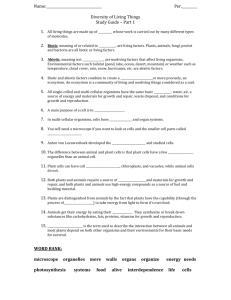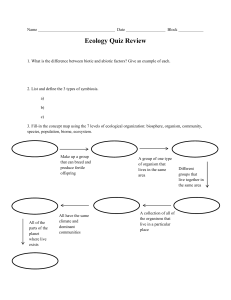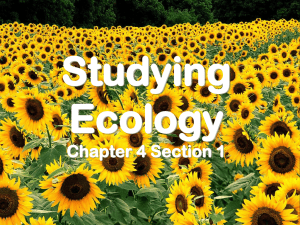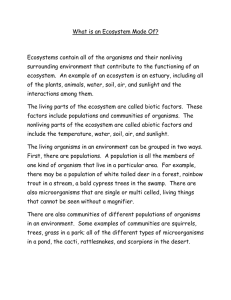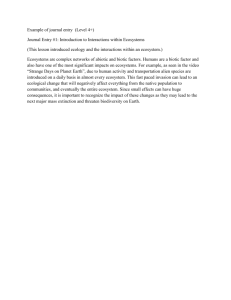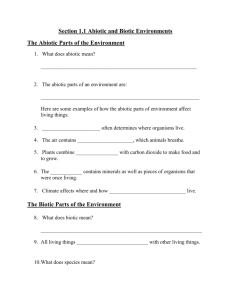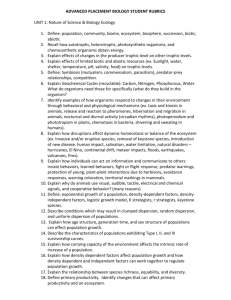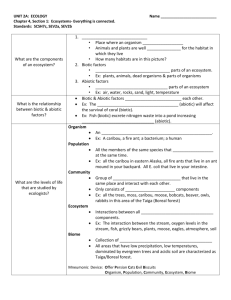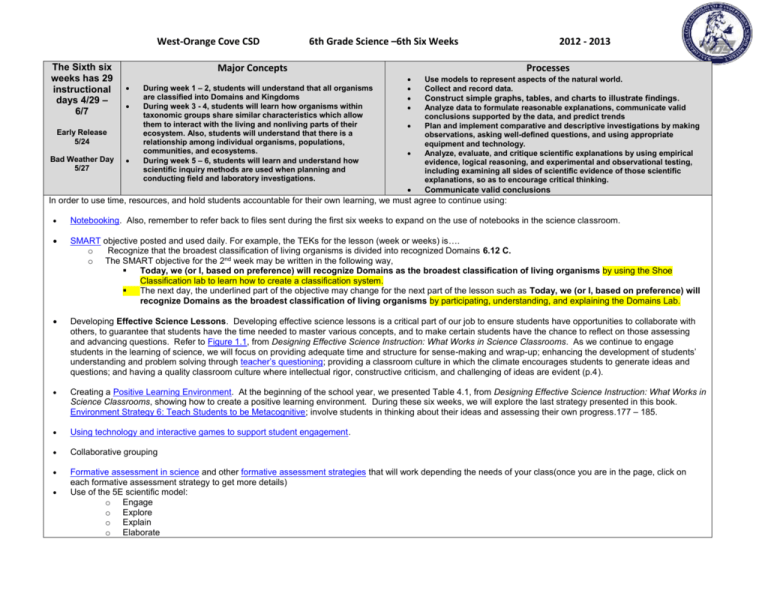
West-Orange Cove CSD
The Sixth six
weeks has 29
instructional
days 4/29 –
6/7
Major Concepts
Early Release
5/24
Bad Weather Day
5/27
6th Grade Science –6th Six Weeks
During week 1 – 2, students will understand that all organisms
are classified into Domains and Kingdoms
During week 3 - 4, students will learn how organisms within
taxonomic groups share similar characteristics which allow
them to interact with the living and nonliving parts of their
ecosystem. Also, students will understand that there is a
relationship among individual organisms, populations,
communities, and ecosystems.
During week 5 – 6, students will learn and understand how
scientific inquiry methods are used when planning and
conducting field and laboratory investigations.
2012 - 2013
Processes
Use models to represent aspects of the natural world.
Collect and record data.
Construct simple graphs, tables, and charts to illustrate findings.
Analyze data to formulate reasonable explanations, communicate valid
conclusions supported by the data, and predict trends
Plan and implement comparative and descriptive investigations by making
observations, asking well-defined questions, and using appropriate
equipment and technology.
Analyze, evaluate, and critique scientific explanations by using empirical
evidence, logical reasoning, and experimental and observational testing,
including examining all sides of scientific evidence of those scientific
explanations, so as to encourage critical thinking.
Communicate valid conclusions
In order to use time, resources, and hold students accountable for their own learning, we must agree to continue using:
Notebooking. Also, remember to refer back to files sent during the first six weeks to expand on the use of notebooks in the science classroom.
SMART objective posted and used daily. For example, the TEKs for the lesson (week or weeks) is….
o
Recognize that the broadest classification of living organisms is divided into recognized Domains 6.12 C.
o The SMART objective for the 2nd week may be written in the following way,
Today, we (or I, based on preference) will recognize Domains as the broadest classification of living organisms by using the Shoe
Classification lab to learn how to create a classification system.
The next day, the underlined part of the objective may change for the next part of the lesson such as Today, we (or I, based on preference) will
recognize Domains as the broadest classification of living organisms by participating, understanding, and explaining the Domains Lab.
Developing Effective Science Lessons. Developing effective science lessons is a critical part of our job to ensure students have opportunities to collaborate with
others, to guarantee that students have the time needed to master various concepts, and to make certain students have the chance to reflect on those assessing
and advancing questions. Refer to Figure 1.1, from Designing Effective Science Instruction: What Works in Science Classrooms. As we continue to engage
students in the learning of science, we will focus on providing adequate time and structure for sense-making and wrap-up; enhancing the development of students’
understanding and problem solving through teacher’s questioning; providing a classroom culture in which the climate encourages students to generate ideas and
questions; and having a quality classroom culture where intellectual rigor, constructive criticism, and challenging of ideas are evident (p.4).
Creating a Positive Learning Environment. At the beginning of the school year, we presented Table 4.1, from Designing Effective Science Instruction: What Works in
Science Classrooms, showing how to create a positive learning environment. During these six weeks, we will explore the last strategy presented in this book.
Environment Strategy 6: Teach Students to be Metacognitive; involve students in thinking about their ideas and assessing their own progress.177 – 185.
Using technology and interactive games to support student engagement.
Collaborative grouping
Formative assessment in science and other formative assessment strategies that will work depending the needs of your class(once you are in the page, click on
each formative assessment strategy to get more details)
Use of the 5E scientific model:
o Engage
o Explore
o Explain
o Elaborate
West-Orange Cove CSD
o
6th Grade Science –6th Six Weeks
2012 - 2013
Evaluate
Using a rubric or a criteria chart generated with the students, go over the expectations in the science lab as it concerns to safety, active participation, homework,
research and other projects.
Week 1 – Week 2
April 29 – May 10
Learning Standards
Organisms and
Environments
The student knows all
organisms are classified
into Domains and
Kingdoms. Organisms
within these taxonomic
groups share similar
characteristics which allow
them to interact with the
living and nonliving parts
of their ecosystem.
Instruction
Essential Vocabulary :
domains, kingdoms, taxonomic groups, ecosystem,
living, non- living
ENGAGE students daily by
The student is expected
to:
Recognize that the
broadest classification of
living organisms is divided
into recognized Domains
6.12 C
Watching the video segment Classification of
Organisms, students will understand about how the
process of classification helps biologists study
Earth’s organisms. Classification is where
scientists organize life forms into groups based on
how they are related to each other. Students will
collaborate to answer the question, “Why is the
classification of organisms important?”
Using various presentations related to classification
in order for students to better understand the
purpose of classification and its importance.
You are part of a group of botanists who have
discovered a rare plant species. Working with a
partner or groups, students will use annotated
drawings or create a cartoon describing the
taxonomic groups and characteristics you will use
to determine which domain and kingdom this plant
belongs in.
Teachers will facilitate students’ learning and discovery
to reinforce skills and concepts
EXPLORE / EXPLAIN – Teacher will guide
students in the understanding of classification
using the Introduction to Classification SMART
Notebook file.
EXPLORE / EXPLAIN – using online resources,
library books, and/or encyclopedias, students will
Resources
https://www.scientificmin
ds.com/Teacher/Ancillary
Data.aspx
Use the following lessons
to support students’
understanding and
knowledge by using
Science Starter 115
Classification
Discovery Education
Background
information on
Kingdoms and
Domains
Science PowerPoint
presentations
Products, Projects, Labs
Assessment
Gateways to Science 6th
grade Unit 5 Lesson 5:
Domains (T.E Not
available – Student Edition
P. 247 - 250)
Students will participate in
this lesson to investigate
and understand more about
Domains.
EVALUATE
Create a criteria chart
and rubric for
students to monitor
their progress.
Students will create a
poster or a
poem/song displaying
their understanding of
classification
Classification of Shoes Lab
or Shoe Classification
(depending on how much
support students need – the
second lesson has more
specific instructions).
Students will participate of
this laboratory to learn how
to create a classification
system and to understand
the reasons for classification
in science.
EXPLAIN / ELABORATE –
students will use their
knowledge of Domains and
create a Venn Diagram to
compare and contrast 2 of
the 3 domains.
Reflection –
Students will describe
and illustrate the
similarities and
differences between
bacteria and archaea.
West-Orange Cove CSD
6th Grade Science –6th Six Weeks
select and research an organism that is classified
in one of the domains
o Name of the organism
o Place of discovery
o Characteristics of the organism
o Interesting facts about the organism
o Create a poster to participate in a gallery
walk
EXPLORE / EXPLAIN – Using the Life on Earth
information, students will learn more about each of
the 3 classification domains.
2012 - 2013
West-Orange Cove CSD
Week 3 – Week 4
May 6 – May 17
Learning Standards
6th Grade Science –6th Six Weeks
Instruction
Organisms and
Environments
The student knows all
organisms are classified
into Domains and
Kingdoms. Organisms
within these taxonomic
groups share similar
characteristics which allow
them to interact with the
living and nonliving parts
of their ecosystem.
Essential Vocabulary :
Biotic, abiotic, ecosystem, organisms, interacts, ecology,
community, population, habitat, and niche
Brainstorm with students using the following
questions
o What do middle schoolers compete for?
o What do adults compete for?
o How does this compare with competition in
nature?
The student is expected
to:
Watching the video clip Ecosystems: Abiotic and
Biotic Factors, students will understand how the
place where an organism lives depends on the biotic
and abiotic factors present in the environment. This
clip compares several ecosystems. A swamp is
described in terms of its biotic and abiotic factor.
Students will create a T-Chart listing biotic and
abiotic factors.
ENGAGE students daily by
Describe biotic and abiotic
parts of an ecosystem in
which organisms interact.
6.12E
Diagram the levels of
organization within an
ecosystem, including
organism, population,
community, and
ecosystem. 6.12F
Understanding the role of non-living, abiotic factors
and the role they play in shaping ecosystems.
Students will learn about five abiotic factors being
examined: water, air, soil, heat, and light. Students
will use graffiti writing or two-minute paper to reflect
on this video and then share with group.
Using the Biotic and Abiotic song, students will learn
the differences between abiotic and biotic
relationships. This is a great exemplar to show
students and have them come up with their own
song, poem, or rap
Taking a walk students select an area outside, on
the school grounds, and identify the biotic and
abiotic factors and how they are related.
Using the stories and pictures of ecosystems
provided in the Abiotic and Biotic SMART Notebook
file students will identify the biotic and abiotic factors
Using a level of organization that students are
Resources
https://www.scientificmi
nds.com/Teacher/Ancill
aryData.aspx
Use the following
lessons to support
students’ understanding
and knowledge by using
Science Starter 14
Biological
Organization
Science Starter 11
Abiotic and Biotic
Science Starter 77
Interactions within
Ecosystems
Discovery Education
My Science Box
Prentice Hall school
2012 - 2013
Products, Projects, Labs
Gateways to Science 6th
grade Unit 5 Lesson 1:
Biotic and Abiotic Factors
(T.E Not available –
Student Edition P. 210 215)
Students will participate in
this lesson to investigate and
understand more about
biotic and abiotic parts of an
ecosystem in which
organisms interact.
Gateways to Science 6th
grade Unit 5 Lesson 2:
Levels of Organization
within an ecosystem (T.E
Not available – Student
Edition P. 216 - 220)
Students will participate in
this lesson to investigate and
understand more about the
levels of organization within
an ecosystem, including
organism, population,
community, and ecosystem.
ELABORATE / EVALUATE
Create a criteria chart and
rubric for students to monitor
their progress.
Students will create a poster,
a poem/song, or an acrostic
displaying their
understanding of biotic and
abiotic.
.
Assessment
EVALUATE
Students will use a
picture (teacher or
students may select
their own picture) to
list the biotic and
abiotic components.
Then, students will
write a paragraph
describing how the
biotic and abiotic
components of the
ecosystem are
interacting.
Reflection –
Students will use
their knowledge of
levels of organization
to read the Levels of
Organization
scenario and reflect
on the students
observations.
West-Orange Cove CSD
6th Grade Science –6th Six Weeks
familiar with such as, a school system. (Ex: student,
teacher, principal) or a family. Using think-pairshare or collaborative groups, students will share
how their levels of organization are similar to ones
that might be found within an ecosystem (use P. 73
to provide a visual if students are not familiar with
this concept).
Teachers will facilitate students’ learning and discovery
to reinforce skills and concepts
EXPLORE / EXPLAIN – Teacher will guide students
in the study of Ecological Relationships to support
students in better understanding how organisms
depend on and may compete for biotic and abiotic
factors.
EXPLORE / EXPLAIN- Teacher will support
students in the understanding of ecosystem
organization. Students will explore the different
levels of an ecosystem (organism, population,
community, ecosystem) by choosing an organism
and creating an ecosystem pyramid about that
organism. (See sample)
2012 - 2013
West-Orange Cove CSD
Week 5 – Week 6
May 28 – June 7
Learning Standards
Scientific Investigation
and Reasoning
The student, for at least
40% of instructional time,
conducts laboratory and
field investigations
following safety
procedures and
environmentally
appropriate and ethical
practices.
6th Grade Science –6th Six Weeks
Instruction
Essential Vocabulary:
problem, hypothesis, observation, experimental design,
scientific method, data, conclusion
Teacher may use a few days to review or reteach
concepts that students did not master, had trouble
understanding, or did not have enough time/practice to
learn or teachers will encourage students to choose
special projects to work on for the next 2 weeks.
Teachers will approve topic and/or testable hypotheses
in order for students to work on purposeful projects
following the scientific method.
The student is expected
to:
Plan and implement
comparative and
descriptive investigations
by making observations,
asking well-defined
questions, and using
appropriate equipment
and technology. 6.2 A
Design and implement
experimental
investigations by making
observations, asking well
defined questions,
formulating testable
hypotheses, and using
appropriate equipment
and technology. 6.2B
Construct tables and
graphs, using repeated
trials and means, to
organize data and identify
patterns. 6.2D
ENGAGE students daily by
Learning about the six steps in the design process
through an exploration of the Wright brothers' story
of flight (12:07 minutes). Students will identify and
describe the steps of the scientific method and how
scientists apply these steps.
Interacting in a game with the steps of the Scientific
Method.
Reviewing the processes of scientific investigations
by participating and discussing the Inquiry Board.
Using the inquiry board will support students to
determine a testable experiment and figuring out a
testable question.
Explaining how graphs, tables, and charts differ and
how scientists present their data using graphs,
tables, charts. Use this link to engage students in
graphing activities- Graphs and/or use a
PowerPoint presentation to EXPLORE various data
analysis tools.
Teachers will facilitate students’ learning and discovery
to reinforce skills and concepts
EXPLORE / EXPLAIN- Teacher will guide students
in the use of the Science Inquiry Board using the
SMART file to show students how to move “sticky
notes” around to generate a research question.
Resources
https://www.scientificmi
nds.com/Teacher/Ancill
aryData.aspx
Use the following
lessons to support
students’ understanding
and knowledge by using
Science Starter 5
Scientific Method
Science Starter 6
Experiments
Discovery Education
PowerPoint
Presentations
Teach-nology
More ideas for Science
Projects
ScienceSpot
2012 - 2013
Products, Projects, Labs
The Egg-Drop Experiment:
Students will construct
some type of container
that will keep a raw egg
from cracking when
dropped from everincreasing elevations.
Students will gain the
ability to design a product
(a container), evaluate the
product, and
communicate the process
of design modification.
Use some of these videos, 2,
3 to scaffold as needed.
Assessment
EVALUATE /
Reflection
As students work on
the Egg-Drop
Experiment, they will
be encouraged to
experiment with a
number of different
designs for this task.
Students will keep a
record (field journal)
of:
Students will use this
resource to choose great
science projects for 6th
graders!! Other ideas or
resources will be approved
by the teacher to make
science fun with a winning
project.
the various
designs
rationales for the
designs
any experiments
performed
subsequent to
the actual EggDrop
If students work on
different project,
students will provide
a lab report at the
end of the project
keeping in mind
similar entries.
West-Orange Cove CSD
6th Grade Science –6th Six Weeks
Students will create their own experiments using the
Independent Investigation format. Teacher may
provide topic and the students create a question and
design an experiment to find an answer. Students
may select from various examples, students work in
pairs to create a question about bouncy balls, such
as "Does the diameter of the ball influence the
height of the bounce?" If time is available after the
labs are completed, the groups exchange
experiments. After the experiments are completed,
the groups meet to discuss the results, which
provides a great opportunity to discuss problems
related to the design of the experiment or data
collection. It is great to see students taking the
initiative to experiment on their own and develop
ways to address errors that could cause unreliable
data. Refer to independent investigation guidelines
and rubric.
2012 - 2013
West-Orange Cove CSD
6th Grade Science –6th Six Weeks
2012 - 2013
SMART Objective
In the book, Learning by Doing, P. 126, Richard DuFour, Rebecca DuFour, Thomas Many, and Robert Eaker, talk about SMART goals and how
establishing these goals will assist stakeholders in creating a collaborative effort oriented by results.
According to Dufour et al, SMART objectives are Strategic and Specific, Measurable, Attainable, Results-Oriented, Timebound. For our
purposes in the classroom, we will use SMART objectives in the following manner:
Standards-based – use the wording of the TEK
Makes a connection – find a way to connect to everyday situation
Attainable - do students feel they can learn the concept?
Results oriented – how will students know they have learned the concept?
Tell – Students are able to tell what they are learning
The objective does not have to change every day as you write it on the board or keep it in a prominent place. Keep in mind that by posting
the learning objective in this manner and using with the students before, during, and after the lesson then the students will know the what,
how, and why of the learning. Besides, using the standard will support the students learn the vocabulary they are expected to know and
master by the end of the lesson.
West-Orange Cove CSD
6th Grade Science –6th Six Weeks
2012 - 2013
Some Examples of Formative Assessments in Science
(Source: Science Formative Assessments by Page Keeley)
Concept Cartoons
(p.71)
Familiar Phenomenon Probe/
Friendly Talk Probe
(p.85 & 102)
Interest Scale
(p.115)
I Used to Think…Now I Know
(p.119)
KWL (and its variations)
(p.128)
Pass the Question
(p.149)
Popsicle Stick Questioning
(p.158)
R.E.R.U.N.
(p.172)
Sticky Bars
(p.178)
Terminology Inventory Probe
(p.180)
-cartoon of people sharing their ideas on common, everyday phenomenon/concept
-students choose the cartoon they agree with most and explain their reasoning
-used to assess and address misconceptions, diagnostic
-see: www.conceptcartoons.com for examples
-a dialogue between characters addressing a concept
-students choose the character they agree with most and explain their reasoning
-used to assess and address misconceptions, diagnostic
-students use sticky notes to indicate their interest in a subject on a low to high scale (e.g. a
thermometer with the heading “How Hot is the Topic?”)
-kinesthetic, student interest
-at the end of a lesson, students reflect and compare what they knew at the beginning of a lesson to
what they know after a lesson
-metacognition, assessment as learning
KWL – what I know, what I wonder, what I learned
OWL – what I observed, what I wonder, what I learned
KWLH – KWL + H = how I learned it
-students begin to respond to a question; halfway through, they exchange responses and complete,
modify, or change each other’s responses
-can be done in pairs and then exchanged with another pair
-cooperative learning
-names of students are written on a popsicle stick
-pull popsicles sticks for name of student to call on (e.g. for questioning)
-reflection/exit card for a lab activity
-recall (summarize), explain the purpose, results (describe their meaning), uncertainties
(list/describe), new things you learned
-to answer a multiple choice question, students write their responses on a sticky note, hand in to
their teacher, teacher posts answers to show the variety of answers from all students
-diagnostic, metacognition
-give a list of terms to students
-students use a checklist to indicate what they know of a term using a range from “I have never
heard of the this” to “I clearly know what it means and can describe it”
-students revisit the list at the end of learning
-ask students to reveal their understanding by providing a description, drawing a picture, etc.
West-Orange Cove CSD
Synectics
(p.186)
Traffic Light Cups
(p.201)
A&D Statements
Annotated Student Drawings
Commit and Toss
Concept Card Mapping Concept
Missed Conception
6th Grade Science –6th Six Weeks
2012 - 2013
-“the fitting together of different and apparently irrelevant elements”
-analogies/metaphors
e.g. a physical change is like a milkshake because different ingredients are put together and
combined to make something different but each ingredient can still be physically separated
-teacher can assess student’s conceptual understanding of a concept
-link to Marzano’s “identifying similarities and differences” instructional strategy
-red, yellow, and green stackable party cups
-used to signal whether a group does not need help from the teacher (green), needs some feedback
or assistance (yellow), or does not know what to do next (red)
-allows teacher to circulate and differentiate the process based on readiness
Students use A & D Statements to analyze a set of “fact or fiction” statements. In the first part
of A & D Statements, students may choose to agree or disagree with a statement or identify
whether they need more information. In addition, they are asked to describe their thinking
about why they agree, disagree, or are unsure. In the second part of the FACT, students
describe what they can do to investigate the statement by testing their ideas, researching what
is already known, or using other means of inquiry.
“If a picture is worth a thousand words, perhaps drawing and visualizing can help science
students enhance their learning potential” (National Science Teacher Association [NSTA],
2006, p. 20. Annotated Student Drawings are student-made, labeled illustrations that visually
represent and describe student’s thinking about a scientific concept.
Commit and Toss is an anonymous technique used to get a quick read on the different ideas
students have in the class. It provides a safe, fun, and engaging way for all students to make
their ideas known to the teacher and the class without individual students being identified as
having “wild” or incorrect ideas. Students are given a question. After completing the question,
students crumple their paper up into a ball and, upon a signal from the teacher, toss the paper balls
around the room until the teacher tells them to stop and pick up or hold on to one paper.
Students take the paper they end up with the share the ideas and thinking that are described
on their “caught” paper, not their own ideas.
Card Mapping is a variation on the familiar strategy of concept mapping (Novak, 1998). Instead of
constructing their own concept maps from scratch, students are given cards with the concepts
written on them. They move the cards around and arrange them as a connected web of knowledge.
They create linkages between the concept cards that describe the relationship between concepts.
Moving the cards provides an opportunity for students to explore and think about different linkages.
A Missed Conception is a statement about an object or phenomenon that is based on a commonly
held idea noted in the research on students’ ideas in science. Students are asked to analyze a
statement, describe why some people may believe it is true, describe what one could do to help
someone change his or her “missed conception” in favor of the scientific idea, and reflect on their
own ideas in relation to the statement.
West-Orange Cove CSD
Two-Minute Paper
6th Grade Science –6th Six Weeks
2012 - 2013
The Two-Minute Paper is a quick and simple way to collect feedback from students about their
learning at the end of an activity, field trip, lecture, video, or other type of learning experience.
Students are given two minutes to respond to a predetermined prompt in writing.
http://www.google.com/url?sa=t&rct=j&q=&esrc=s&source=web&cd=3&ved=0CHYQFjAC&url=http%3A%2F%2Fdpcdsbcla.wikispaces.com%2Ffile%2Fview%2FSome%2BExamples%2Bof%2BFormative%2BAssessments%2Bin%2BScience.doc&ei=w5fmT6iMCIfm2
QXOueHZCQ&usg=AFQjCNGgWKsjp9jPPrnqbALNk3Gc7vpP5Q&sig2=cY2Br5Y_HYLjmrQRQ5MBGw
West-Orange Cove CSD
6th Grade Science –6th Six Weeks
2012 - 2013
Graffiti Writing
Graffiti Writing is a cooperative learning structure that facilities brainstorming and also doubles
as a group energizer. Each cooperative group of 3 or 4 students is given a piece of chart paper
and different colored markers. Group #1 might have black markers; group #2 green markers,
etc. There needs to be a different color marker for each group so that the teacher can track
each individual group’s contribution. If you have small enough classes you can give each
student a different color marker and track individual performance, but this is not usually
possible. Each group is given a different question, topic, issue, or statement to which they
respond. All students can respond to the same topic but I find it more effective if three or more
different topics are used. For a short time period (3-5 minutes), every group writes their “graffiti”
(words, phrases, statements, pictures) on their particular topic. For example: Your students
have just read the book Who Moved My Cheese; I would use a graffiti sheet for each character
and have students describe these characters with words, phases, and pictures. All students in
the group write on the same piece of chart paper at the same time. It is very important that, as
the teacher you monitor total participation to get the most out of this activity. After about three to
five minutes, the teacher stops the groups and asks each group to pass their graffiti sheets to
the next group. The new group with the sheet reads what has already been written or drawn on
the sheet and adds additional new information. Continue the process until each group’s original
sheet has been returned to them. Once a group has their original sheet back, as a group, they
read all of the contributing comments, discuss them, summarize them, and prepare a brief
presentation to the class as outlined by the teacher. I often have the students categorize the
comments in order to draw conclusions as part of their presentation phase. A specific outcome
must be set by the teacher for the presentation part of this assignment in order for it to be
effective.
Graffiti writing works very effectively as an anticipatory set, a closure activity or as an energizer
during any lesson where the generation of ideas or the recall of facts is desired. Please
encourage your students to draw during graffiti writing as this will motivate students who love to
doodle and often are not super productive in your classroom. Also, for extremely large classes
the same lesson can be going on twice in your classroom which will result in two groups
presenting on the same topic at the end. This keeps both groups and the scope of the lesson
appropriate in size and depth.
http://keystoteachingsuccess.blogspot.com/2009/07/graffiti-writing.html
West-Orange Cove CSD
6th Grade Science –6th Six Weeks
2012 - 2013
Biotic Acrostic Poem
An acrostic poem is one where you choose a word or name and use each letter in the name as the beginning of a
word or line that tells something about that person or topic.
Example: An acrostic poem using the word "Sun."
Sometimes when we go to the beach, I will get sun burn.
Usually if I put Sun block on my skin, I will not burn.
Noon is when I'm really prone to burning.
Write an Acrostic Poem using the word below (may substitute for ABIOTIC).
B
I
O
T
I
C
Modified from The Online Teacher Resource (www.teach-nology.com)
© Teachnology, Inc. All rights reserved.

